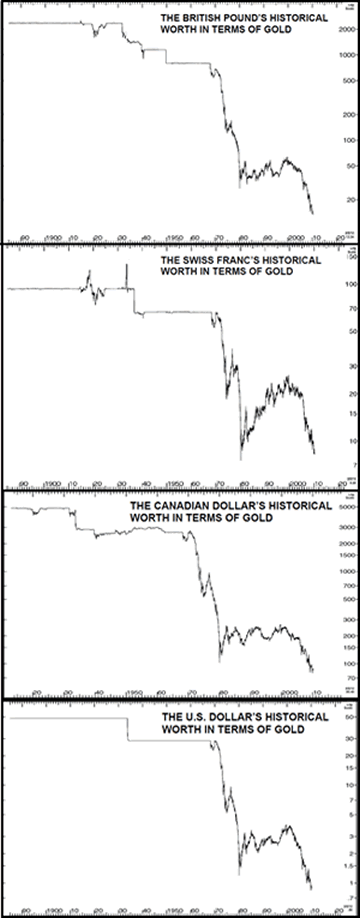Euro Speeding Towards the Currency Graveyard
Currencies / Fiat Currency Apr 06, 2010 - 11:07 AM GMTBy: Larry_Edelson
 Between 1998 and 2002 I published several articles on how the just born euro currency would ultimately fail, resulting in the collapse of the European Monetary Union.
Between 1998 and 2002 I published several articles on how the just born euro currency would ultimately fail, resulting in the collapse of the European Monetary Union.
Almost everyone, even my colleagues, scoffed at my forecast. But my reasoning was sound: No matter what the short-term benefits of the new euro, mainly in trade within Europe, I said, long term, there was no way the euro would survive, because …
A. There was no political union in Europe, and there still isn’t. The European Union’s Charter is nothing like the Constitution of the United States, nor the set of Federal and State laws that have been mapped out over the last 234 years in the U.S.
Plus, in Europe, each country’s nationalistic pride, and each country’s culture, is far more deeply ingrained than in the U.S. which is far younger and was formed as a melting pot, with immigrants from all over the world.
In contrast, countries in Europe are thousands of years old. Trying to unify them and their many disparate cultures and 23 official languages with a single currency, I said over and over again, would simply not work on a cultural basis alone.
In short, there is no United States of Europe. There never was, and will likely never be one.
Moreover …
B. There’s no true central bank behind the euro currency. There is the official European Central Bank (ECB). BUT, the ECB is virtually nothing more than a figurehead bank. It does set interest rate and fiscal benchmarks, but importantly, in Europe each country’s own central bank has remained in place and still has the option of setting its own fiscal and monetary policies.
That’s like the state of Connecticut being able to set a different interest rate and monetary policy than, say, New York. That may work in the short run, but no way would it work in the long term.
The main function of a central bank is to smooth out a country or region’s seasonal cash flows, to foster economic growth commensurate with population growth, and to provide liquidity in the event of natural disasters and unusual circumstances that cause massive geographic shifts in liquidity.
Such as what happened in this country after the 1906 San Francisco earthquake, which caused massive disruptions in cash flow and commerce, and which gave birth to the Federal Reserve.
It is not to set monetary or fiscal policy, which is what has gone wrong with today’s central banks, in general. In the U.S., the Federal Reserve is deeply involved in fiscal and monetary policy, even to the extent that it can hold the country practically hostage to its ways. Which has clearly gotten out of hand.
But it’s even worse in Europe — where each country’s central bank can effectively act independently of the European Central Bank!
 |
| As the Greek sovereign debt crisis spreads, it is becoming apparent that the European Monetary Union is doomed to failure. |
Short term, naturally, all this is clobbering mostly the euro, as the European Union deals with the Greek sovereign debt crisis.
And Greece isn’t the only country in trouble in Europe. Just over a week ago, ratings agency Fitch downgraded Portugal’s credit rating one notch to AA-, warning that Portugal faces “a sizeable fiscal shock.”
Italy and Spain will be next to get hit. Then Britain, whose currency is already taking a shellacking.
But Make No Mistake About It: The U.S. Faces The Same Fiscal Nightmare, And The Dollar Will Not Survive It Either.
Although here in the U.S. we do not have the same exact problems as the European Union, nor the same flawed designs of the European Central Bank — we do have the same problem of being dead broke as a nation.
Deeper in the hole than any civilization in history.
And once this sovereign debt crisis hits the U.S., I have absolutely no doubt in my mind that the U.S. dollar will also get clobbered, eventually losing as much as 50% of its current purchasing power in international terms, and perhaps even more domestically.
To the point where someday in the not-too-distant future, the dollar may even cease to exist.
Think it can’t happen? Nearly 4,000 paper currencies have come and gone in the history of civilization, ending up as nothing more than a heap of garbage in the currency graveyard.
Naturally, over the next few years, the world’s currency system is going to go through wild gyrations. But long term, the financial crisis which started in real estate and is now migrating to sovereign debt, are merely the opening acts of …
The Complete Collapse Of The Current Fiat Monetary System.
 |
In reality, it’s been a slow motion collapse, all along. VIRTUALLY EVERY MAJOR CURRENCY ALIVE TODAY HAS BEEN LOSING PURCHASING POWER FOR DECADES.
The only difference between the last several decades of currency depreciation and what’s going to happen over the next few years in an accelerated plunge …
… is that now you are witnessing the death throes of that system, where the current fiat system effectively goes to ZERO value — giving birth to an entirely new world monetary order.
For now, in case you have any doubts about the collapse of fiat money, I’d like you to take a look at these four charts I have for you today from Topline Investment Graphics and SafeWealth.
Consider the 100-year plunge in the once mighty British pound …
The once iron-clad Swiss franc …
The Canadian dollar …
And the U.S. dollar …
Now making a beeline toward the same currency graveyard where nearly 4,000 other failed currencies lay dead before them.
The sovereign debt crisis? It is simply the trigger that will bring us from point A …
To point B: Complete reform of the world’s entire monetary system.
As many of you know, I have been on the leading edge of this forecast. In fact, I’ve been as right as rain on it, even predicting 10 years ago that a major monetary crisis would hit the world by the year 2012, causing a wholesale rewriting of all the “rules of the game,” as central bankers like to call them.
Eventually replacing the dollar as the world’s reserve currency, and forcing the world into either a single world currency, or, at minimum, a single international currency for global trade.
 |
| A complete reform of the world’s monetary system is in the offing. |
And last year, I warned the world how Bernanke was embracing the wholesale printing of an unlimited amount of dollars to try and solve the financial crisis, while knowing full well that it would rob American’s of their wealth.
The new monetary system you will see emerge in a few years time will be radically different from what we have today, and I’m drafting my own proposals to send to Washington to lay out its design, and which you will be amongst the first to see.
We are edging closer and closer to my forecasts, and what will prove to be absolute chaos over the next two years, including …
Devastating Losses For Those Who Do Not Understand What’s Happening. But Humongous Profits For Those Who Do!
Understanding what’s happening now and what’s going to happen are the keys to either losing vast amounts of wealth in the years ahead, on the one hand …
… Or making more money than you ever dreamed of, on the other.
And importantly, almost everything that investors deem safe today will soon become some of the riskiest investments around.
Your savings, if purely in cash and the U.S. dollar, could lose its purchasing power like grains of sand on the edge of a beach being washed out to sea.
Investments in supposedly “safe” instruments like long-term bonds could be absolutely crushed. Ditto for municipal bonds.
Investing in foreign currencies may not even protect your wealth, as the entire world’s monetary system goes through a massive heart attack … resuscitation … and is then replaced with a new heart.
By far and away, the best protection … and the biggest profits … will come from tangible, hard assets …
![]() Assets which cannot be printed or even manufactured at will …
Assets which cannot be printed or even manufactured at will …
![]() Assets whose supplies are strictly finite …
Assets whose supplies are strictly finite …
![]() Assets that are in demand on a daily basis by 6.3 billion people, and …
Assets that are in demand on a daily basis by 6.3 billion people, and …
![]() Assets that have a high tendency to rise in value as governments go broke and fiat money collapses in value.
Assets that have a high tendency to rise in value as governments go broke and fiat money collapses in value.
Natural resource markets will benefit the most. Gold, oil, silver, platinum, palladium, copper, water.
Rare earth metals too, critical to the advancement of technology and science, and of which there are only 17 elements, including scandium, yttrium, and neodymium, critical in electronic components and for the future of hybrid cars and alternative energy.
And it will be very bullish as well for basic necessities, from cocoa, sugar and coffee … to lumber, soybeans, corn, wheat, and dozens more.
But mark my words on this forecast as well: In the long run, the sovereign debt crisis and currency meltdown will also prove to be wildly bullish for blue-chip stocks, even the Dow Jones Industrials — as it resets itself to the unknowns of an eventual dollar devaluation.
Just as major stock indices have done in third-world countries that have experienced debt crises … currency devaluations … and rewritten monetary systems.
The only difference: Today, instead of the debt and currency crisis occurring in some far-away “third-world” country — it’s occurring in the FIRST WORLD.
No matter what, hold your core long-term gold positions. And if you don’t own gold, I strongly suggest you buy some now.
Best wishes,
Larry
This investment news is brought to you by Uncommon Wisdom. Uncommon Wisdom is a free daily investment newsletter from Weiss Research analysts offering the latest investing news and financial insights for the stock market, precious metals, natural resources, Asian and South American markets. From time to time, the authors of Uncommon Wisdom also cover other topics they feel can contribute to making you healthy, wealthy and wise. To view archives or subscribe, visit http://www.uncommonwisdomdaily.com.
© 2005-2022 http://www.MarketOracle.co.uk - The Market Oracle is a FREE Daily Financial Markets Analysis & Forecasting online publication.



